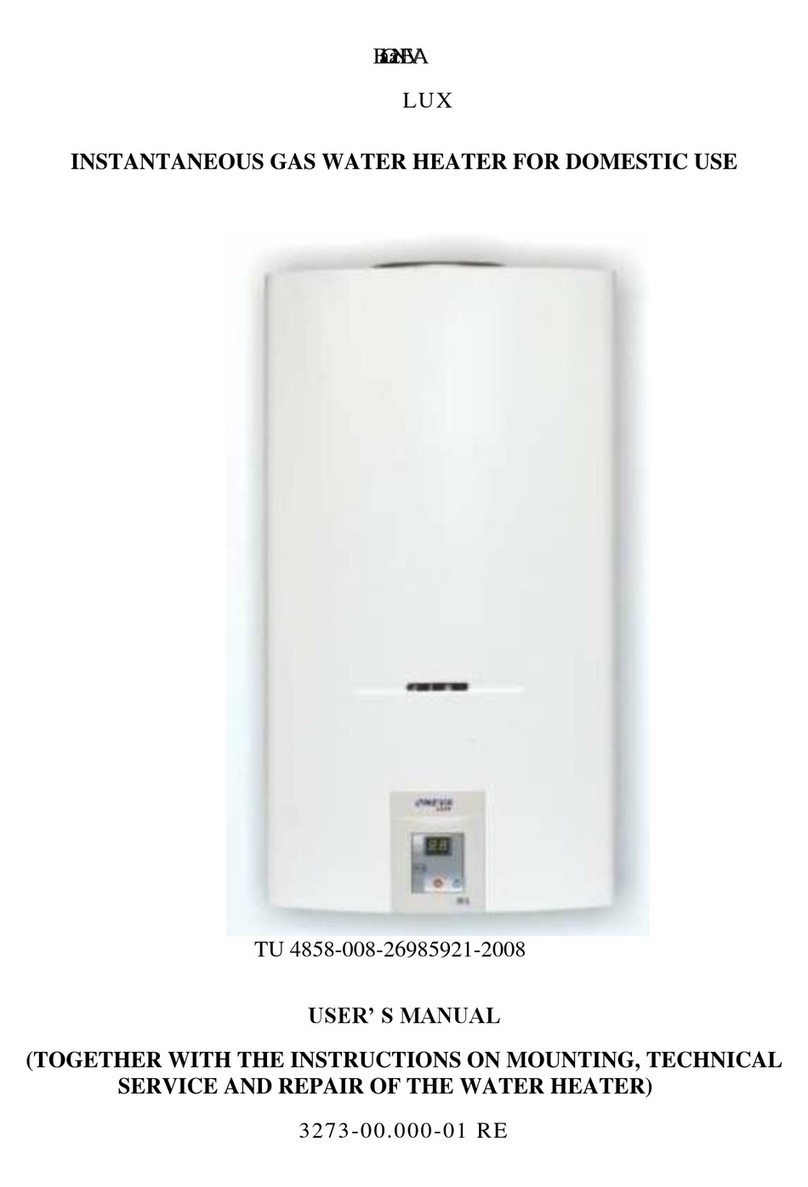TABLE OF CONTENTS
1. SAFETY
MEASURES.......................................................................................................................................................4
2.Technical description………………………………………………………………………………………………...………………5
2.1.Boiler’s purpose………………………………………………………………………………………………………………………5
2.2.Technical characteristics……………………………………………………………………………………….....………………5
2.3.Overall and connection dimensions…………………………………………………………………………………….……6
3. USER’S MANUAL…………………………………………………………………………………………..…………….…8
3.1 Control panel..........................................................................................................................………….…8
3.2 Boiler’s operating modes .......................................................................................................………….…9
3.2.1 Standby mode ....................................................................................................................……….……9
3.2.2. DHW mode ........................................................................................................................……….……9
3.2.3 Combined mode...................................................................................................................………...…10
3.2.4 Heating mode.......................................................................................................................………...…10
3.3. Additional functions..............................................................................................................………...…10
3.3.1 Antifreeze function.............................................................................................................………...…10
3.3.2 Anti-blocking function........................................................................................................…………10
3.3.3 Boiler’s operation in heating mode with an external (outdoor) temperature
sensor……………………………………………………………………………………………………….....10
3.3.4 Boiler’s operation at low /high source voltage……………………………………………………..………………11
4. BOILER SERVICE .................................................................................................................…………11
4.1 Examination ...........................................................................................................................…………11
4.2 Boiler Treatment....................................................................................................................…………11
4.3 Operations effectuated at technical service.........................................................................…………12
5. STORAGE PRECAUTIONS..................................................................................................…………12
6. GENERAL REQUIREMENTS.............................................................................................…………12
7.OPERATIONS BEFORE INSTALLATION.........................................................................…………13
7.1 DHW line ................................................................................................................................…………13
7.2 Heating system .......................................................................................................................…………13
7.2.1 Water quality requirements...............................................................................................………….13
7.2.2 Propylenglycolum usage conditions ..................................................................................………….14
7.2.3 New heating system.............................................................................................................………….14
7.2.4 Existing heating system ......................................................................................................………….14
7.3 Selection of an additional expansion tank............................................................................………….14
8.BOILER INSTALLATION .....................................................................................................………….14
8.1 Mounting the boiler to the wall ...........................................................................................………….14
8.2 Connecting the boiler to the heating system and the DHW system ..................................………….15
8.3 Connecting the boiler to the gas pipeline.............................................................................………….15
8.4 Connecting the boiler to the liquefied gas cylinder.............................................................………….16
8.5 Connecting the boiler to the power line .............................................................................………….16
9. SMOKE EXHAUSTER INSTALLATION...........................................................................………….17
9.1 Installation of coaxial smoke exhauster ..............................................................................………….17
9.2 Installation of separate pipes of smoke exhauster and air
circuit…………………………………………………………………………………………………………18
9.2.1Installation of separate pipes of smoke exhauster and air circuit by means of transitional set
KHG 714061510………………………………………………………………………………………...……18
9.2.2 Installation of separate pipes of smoke exhauster and air circuit by means of channel separator
8023-10.000 ...................................................................................................................................………...…19
10.PUTTING THE BOILER INTO OPERATION (INITIAL RUN).....................................…………22
10.1 Filling the CH and prelaunching check .............................................................................…………22
10.2 Check of combustion parameters.......................................................................................…………23
10.3Additional abilities (options) ..............................................................................................…………23
10.3.1 Connection of room thermostat .................................................................................…………23
10.3.2 Remote control connection .........................................................................................…………23
10.3.3 Connection of external temperature sensor ..............................................................…………24
10.3.4 Connection of a computer for diagnostics ..................................................................…………24
10.4 Switching the boiler off .....................................................................................................…………24
10.5 Water drain from the boiler’s CH......................................................................................…………24
11. BOILER’S POWER REGULATION ..................................................................................…………25
11.1Preparing for operation…………………………………………………………………………….…25
11.2 Checking gas pressure by the regulator’s inlet………………………………………………………25
11.3 Regulating rated pressure .................................................................................................…………25
11.4 Regulating minimal pressure.............................................................................................…………26
11.5 End of operation .................................................................................................................…………26
12. RENDERING THE BOILER TO ANOTHER TYPE OF GAS .......................................…………26
13. FLOW CHARTS AND BOILER OPERATION CONTROL...........................................…………27
13.1 Boiler’s flow chart ...............................................................................................................…………27
13.2 Main components ...............................................................................................................…………29
13.2.1 Control system...............................................................................................................…………29
13.2.2 Hydraulic system .........................................................................................................…………29
13.2.3 Gas system .....................................................................................................................…………29
13.2.4. Smoke exhausting system ...............................................................................................................29
13.2.5. Regulation devices...........................................................................................................................29
13.2.6. Safety devices...................................................................................................................................30
13.3. Service functions..................................................................................................................................30
13.3.1. Parameters programming function...............................................................................................30
13.3.2. Gas analysis function ......................................................................................................................31
13.4. Boiler’s operating logic .......................................................................................................................31
13.4.1. Boiler’s operation in heating mode: .............................................................................................31
13.4.2. Boiler’s operation in DHW mode:................................................................................................32
13.4.3. Boiler’s operation in combined mode............................................................................................33
14. SEARCH FOR FAILURES AND THEIR ELIMINATION...........................................................34
14.1. Error codes...........................................................................................................................................34






























